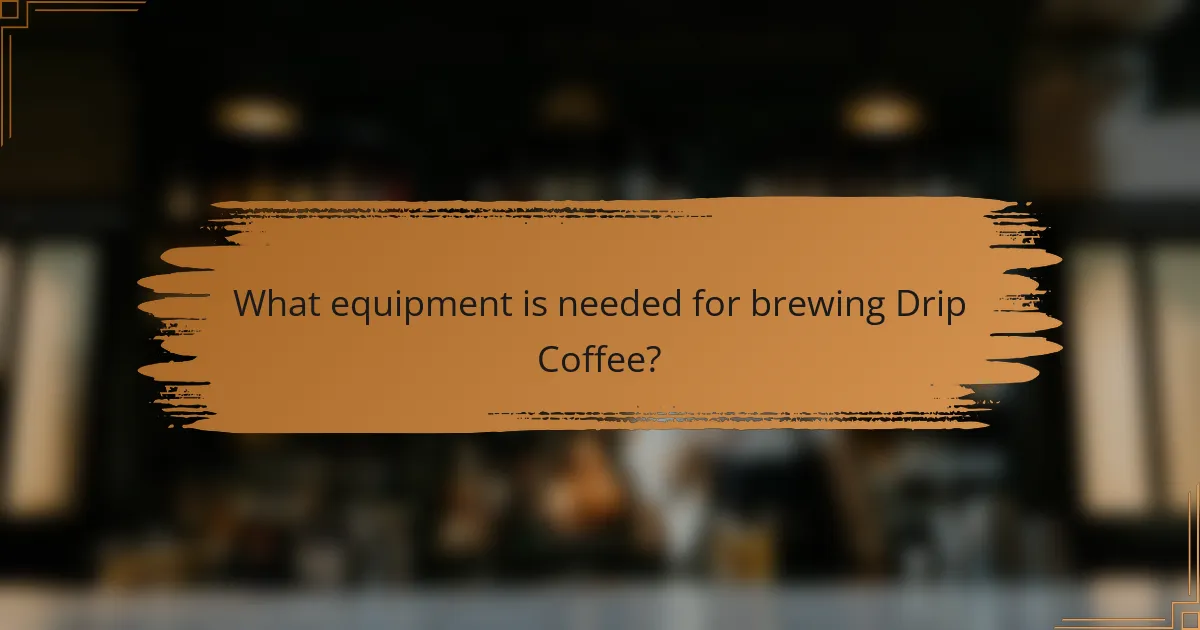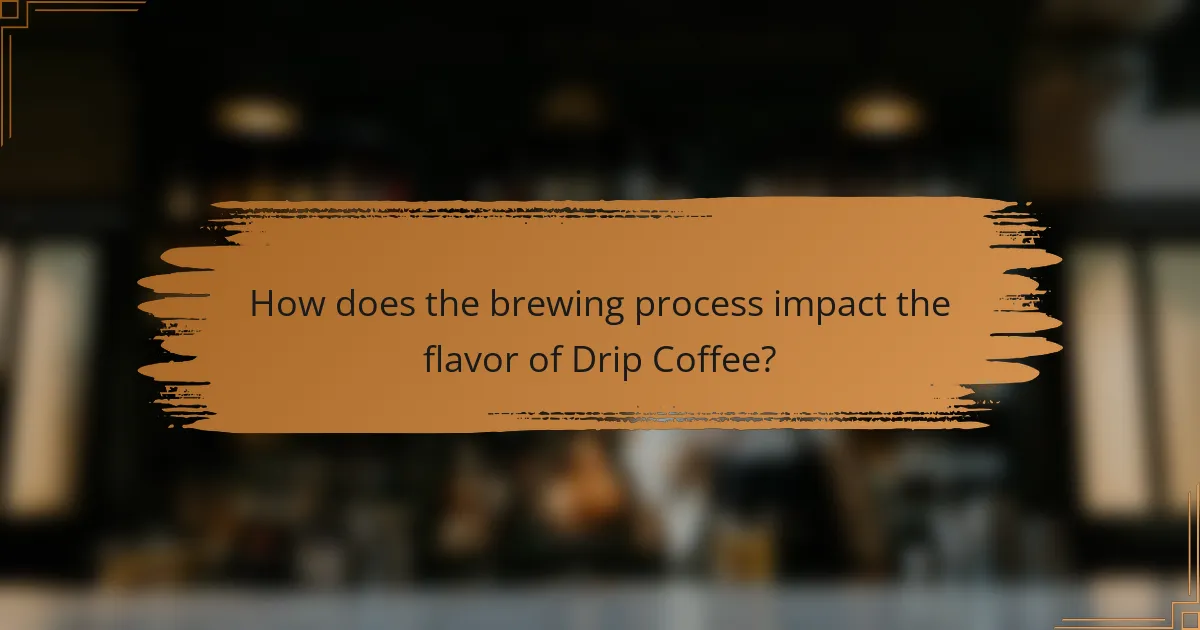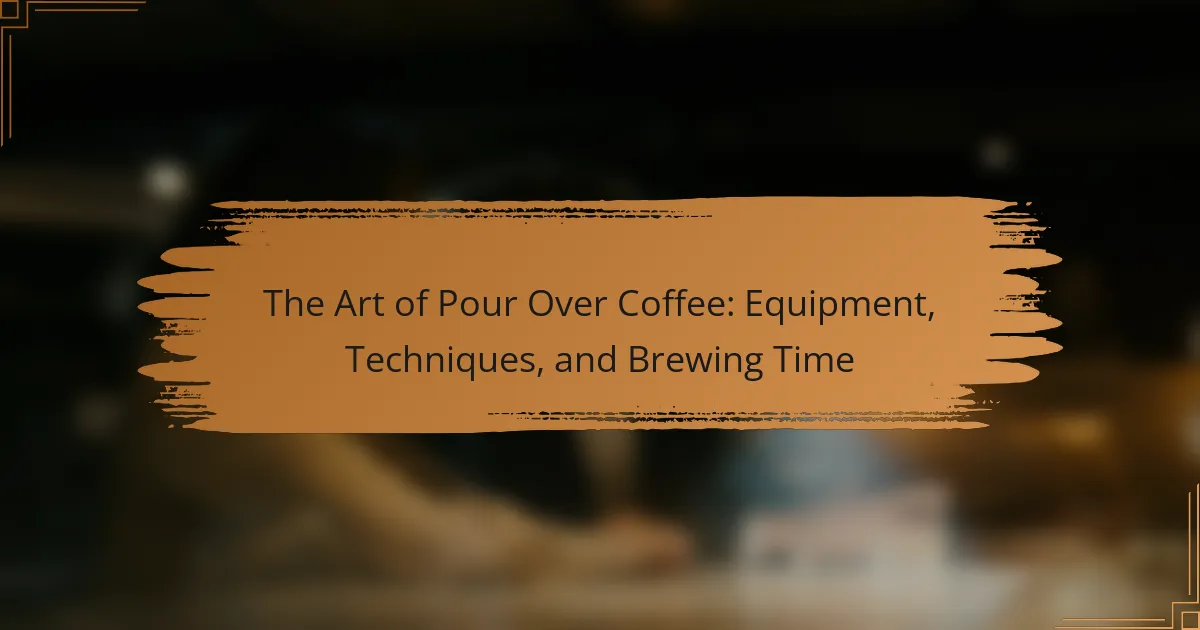
What is Drip Coffee?
Drip coffee is a method of brewing coffee by allowing hot water to flow through coffee grounds. This process extracts flavors and compounds from the grounds. Typically, a drip coffee maker is used for this brewing method. The machine heats water and drips it over the coffee grounds contained in a filter. As the water passes through, it absorbs oils and essences from the coffee. The brewed coffee then drips into a carafe or pot below. Drip coffee is known for its convenience and consistent flavor profile. It is one of the most common brewing methods worldwide.
How is Drip Coffee different from other brewing methods?
Drip coffee is different from other brewing methods primarily due to its automated process. In drip coffee, hot water slowly passes through coffee grounds in a filter. This method allows for precise control over brewing time and temperature. Other methods, like French press or espresso, involve different extraction techniques. For example, French press uses immersion brewing, which results in a fuller body. Espresso relies on pressure to extract flavors quickly. Drip coffee typically yields a cleaner taste with less sediment. It is also often more convenient for making larger quantities at once.
What are the key characteristics of Drip Coffee?
Drip coffee is characterized by its brewing method, flavor profile, and equipment used. The brewing method involves hot water passing through coffee grounds. This extraction process typically takes about 4 to 6 minutes. Drip coffee often has a balanced flavor, with a medium body. The acidity level is usually moderate, appealing to a wide range of coffee drinkers. Common equipment includes automatic drip coffee makers or pour-over devices. The grind size for drip coffee is generally medium to ensure optimal extraction. Water temperature during brewing is ideally between 195°F to 205°F. These characteristics contribute to a consistent and accessible coffee experience.
Why is Drip Coffee popular among coffee drinkers?
Drip coffee is popular among coffee drinkers due to its convenience and consistent flavor. The brewing process allows for easy preparation, requiring minimal effort and equipment. Coffee grounds are steeped in hot water, extracting flavors effectively. This method can produce a clean and balanced cup of coffee. Additionally, drip coffee makers often have programmable features, enhancing user convenience. According to the Specialty Coffee Association, drip coffee is the most common brewing method in the U.S., indicating its widespread acceptance. The ability to brew multiple cups at once caters to households and offices, further contributing to its popularity.
What are the benefits of choosing Drip Coffee?
Drip coffee offers several benefits. It provides a consistent brewing process that enhances flavor extraction. The method allows for precise control over brewing time and water temperature. This results in a balanced taste profile. Drip coffee is also convenient for making multiple cups at once. Many drip coffee makers have programmable features. These features allow users to set brewing times in advance. Additionally, drip coffee is often easier to clean than other brewing methods. This simplicity makes it a popular choice among coffee enthusiasts.
How does Drip Coffee enhance flavor profiles?
Drip coffee enhances flavor profiles by allowing precise control over brewing variables. This method extracts a balanced range of flavors from coffee grounds. Water temperature, grind size, and brew time can be adjusted for optimal extraction. The drip process promotes even saturation of coffee grounds, ensuring uniform flavor release. Studies show that brewing at 195-205°F maximizes aromatic compounds. Additionally, the filter used can influence clarity and brightness in the cup. A paper filter, for example, removes oils, resulting in a cleaner taste. Conversely, a metal filter retains oils, adding body and richness. This versatility in brewing techniques allows for diverse flavor experiences in drip coffee.
What health benefits are associated with Drip Coffee?
Drip coffee offers several health benefits. It is rich in antioxidants, which help combat oxidative stress in the body. Studies indicate that coffee consumption may lower the risk of certain diseases. For example, research published in the journal “Circulation” shows that regular coffee drinkers have a reduced risk of heart disease. Additionally, caffeine in drip coffee can enhance cognitive function and improve mood. According to a study in “Psychological Medicine,” caffeine intake is linked to lower rates of depression. Furthermore, drip coffee may support metabolic health by increasing fat oxidation. Research in “The American Journal of Clinical Nutrition” suggests that coffee can boost metabolic rate. These benefits make drip coffee a popular choice for many health-conscious individuals.

What equipment is needed for brewing Drip Coffee?
To brew drip coffee, you need a drip coffee maker, coffee filter, and ground coffee. A drip coffee maker is essential for the brewing process. It heats water and allows it to flow through the coffee grounds. Coffee filters are necessary to separate the grounds from the brewed coffee. Ground coffee is the primary ingredient that provides flavor. Additionally, a measuring spoon or scale helps ensure the correct coffee-to-water ratio. A carafe is useful for serving the brewed coffee. Finally, access to clean water is crucial for the brewing process.
What types of coffee makers are available for Drip Coffee?
The types of coffee makers available for drip coffee include automatic drip coffee makers, single-serve machines, and pour-over coffee makers. Automatic drip coffee makers are the most common. They brew multiple cups of coffee at once. Single-serve machines offer convenience for one cup at a time. Pour-over coffee makers require manual operation and control over brewing time. Each type has its unique features and brewing methods. Automatic models often have programmable settings. Single-serve machines use pods for easy cleanup. Pour-over makers allow for customization of coffee strength.
How do automatic and manual coffee makers differ?
Automatic coffee makers brew coffee with minimal user intervention. They typically feature programmable settings for convenience. Automatic machines often have built-in grinders and water reservoirs. This allows for consistent brewing temperatures and times. Manual coffee makers require more hands-on preparation. Users control the brewing process, including water temperature and pouring technique. This can lead to varied flavor profiles based on user skill. Automatic coffee makers usually produce coffee more quickly. In contrast, manual methods may enhance the brewing experience. These differences cater to varying preferences in coffee preparation.
What features should you look for in a Drip Coffee maker?
When selecting a drip coffee maker, consider features such as brew strength control, programmable settings, and a thermal carafe. Brew strength control allows customization of coffee intensity. Programmable settings enable pre-setting brew times for convenience. A thermal carafe keeps coffee hot without a warming plate, preserving flavor. Look for a built-in grinder for fresh grounds. An auto shut-off feature enhances safety by turning off the machine after brewing. A removable water reservoir simplifies filling and cleaning. Finally, check for a filter basket that accommodates paper or permanent filters for flexibility. These features collectively enhance the brewing experience and coffee quality.
What accessories can improve your Drip Coffee experience?
Coffee filters can enhance your drip coffee experience. High-quality filters prevent grounds from entering the brew. They also improve flavor clarity by removing unwanted oils and sediments. A scale ensures precise measurements of coffee and water. Accurate ratios lead to consistent brewing results. A thermal carafe keeps coffee hot without a warming plate. This prevents over-extraction and preserves flavor. A coffee grinder allows for fresh grounds, enhancing aroma and taste. Freshness significantly impacts the overall coffee experience. Finally, a water kettle with temperature control allows for optimal brewing temperatures. Proper temperature extraction maximizes flavor compounds in the coffee.
How do grinders affect the quality of Drip Coffee?
Grinders significantly impact the quality of drip coffee. The grind size affects extraction rates. A consistent grind size ensures even extraction. Unevenly ground coffee can lead to over-extraction or under-extraction. Over-extraction results in bitterness, while under-extraction leads to sourness. Burr grinders provide a uniform grind, enhancing flavor consistency. Blade grinders produce uneven particles, negatively affecting taste. Research indicates that grind size directly correlates with flavor profile and aroma. Therefore, selecting the right grinder is crucial for optimal drip coffee quality.
What role do filters play in the brewing process?
Filters in the brewing process serve to separate coffee grounds from the liquid coffee. They ensure a clean brew by preventing sediment and unwanted particles from entering the final product. Coffee filters can be made from paper, metal, or cloth. Each type affects the flavor and clarity of the coffee differently. Paper filters absorb oils and fine particles, resulting in a lighter body. Metal filters allow more oils through, producing a richer flavor. The choice of filter impacts the overall taste and quality of the brewed coffee. Studies indicate that filter type can significantly influence the extraction process and flavor profile.

How does the brewing process impact the flavor of Drip Coffee?
The brewing process significantly impacts the flavor of drip coffee. Factors such as water temperature, brew time, and coffee grind size influence extraction. Optimal water temperature ranges from 195°F to 205°F. This temperature range extracts desirable flavors without introducing bitterness. Brew time typically lasts between 4 to 6 minutes. Longer brew times can lead to over-extraction, resulting in a bitter taste. The grind size also plays a crucial role; a medium grind is ideal for drip coffee. A finer grind may cause over-extraction, while a coarser grind can lead to under-extraction. Each of these brewing variables directly affects the balance of acidity, sweetness, and bitterness in the final cup.
What are the steps involved in brewing Drip Coffee?
Start by gathering your equipment. You need a coffee maker, filter, coffee grounds, and water. Measure the coffee grounds. A common ratio is two tablespoons of coffee per six ounces of water. Place the filter in the coffee maker’s basket. Add the measured coffee grounds to the filter. Pour water into the coffee maker’s reservoir. Turn on the coffee maker to start the brewing process. Once brewing is complete, pour the coffee into a cup and enjoy.
How does water temperature influence extraction?
Water temperature significantly influences extraction in coffee brewing. Higher temperatures generally increase the solubility of coffee compounds. This leads to a more efficient extraction of flavors and oils. Optimal water temperature for drip coffee is typically between 195°F and 205°F. At these temperatures, desirable compounds like caffeine and aromatic oils dissolve effectively. Conversely, water below 195°F can result in under-extraction. This leads to a sour taste due to the insufficient release of sugars and oils. Additionally, water temperatures above 205°F may cause over-extraction. This results in bitter flavors from undesirable compounds. Therefore, maintaining the correct water temperature is crucial for achieving balanced flavor profiles in drip coffee.
What is the importance of coffee-to-water ratio?
The coffee-to-water ratio is crucial for achieving optimal flavor in brewed coffee. This ratio determines the strength and extraction of the coffee. A common guideline is to use one to two tablespoons of coffee per six ounces of water. This balance influences the coffee’s taste, aroma, and body. Incorrect ratios can lead to under-extraction or over-extraction. Under-extraction results in sour or weak flavors. Over-extraction can cause bitterness. Research shows that a ratio of 1:15 to 1:18 is generally preferred for drip coffee. This range helps to enhance the coffee’s natural flavors while avoiding undesirable notes.
What flavor considerations should you keep in mind?
Flavor considerations in drip coffee include the coffee bean origin, roast level, grind size, and brewing time. The origin influences flavor profiles, such as fruity or nutty notes. Roast level affects bitterness and acidity, with lighter roasts being more acidic and darker roasts offering a bolder taste. Grind size impacts extraction; a coarser grind results in a milder flavor, while a finer grind enhances intensity. Brewing time is also crucial; longer brewing can lead to over-extraction and bitterness. Each of these factors plays a significant role in determining the final flavor of the coffee.
How do different coffee beans affect the taste of Drip Coffee?
Different coffee beans significantly affect the taste of drip coffee. The flavor profile of coffee beans varies based on their origin, processing method, and roast level. For instance, Arabica beans tend to be sweeter and more acidic, while Robusta beans are often stronger and more bitter.
Origin plays a crucial role; Ethiopian beans may provide fruity and floral notes, whereas Colombian beans are known for their balanced flavors. The processing method also impacts taste; washed beans generally have a cleaner profile, while natural processed beans can be fruitier.
Furthermore, the roast level influences flavor; light roasts highlight acidity and brightness, while dark roasts deliver bold and smoky flavors. According to the Specialty Coffee Association, the choice of bean can alter the overall sensory experience of the coffee by up to 30%.
What brewing techniques can enhance flavor?
Brewing techniques that can enhance flavor include adjusting water temperature, grind size, and brew time. Higher water temperatures, typically between 195°F and 205°F, extract flavors more effectively. A finer grind size increases surface area, allowing for better extraction. However, too fine a grind can lead to over-extraction and bitterness. Optimizing brew time is crucial; a standard range is between 4 to 6 minutes for drip coffee. Additionally, using fresh, quality coffee beans significantly impacts flavor. The freshness of the beans ensures maximum flavor retention. These techniques collectively improve the overall taste profile of drip coffee.
What are some tips for perfecting your Drip Coffee?
Use fresh, high-quality coffee beans for the best flavor. Freshness affects taste significantly. Grind the beans just before brewing for optimal aroma and flavor extraction. A medium grind is ideal for drip coffee. Measure the coffee-to-water ratio accurately. A standard ratio is 1 to 2 tablespoons of coffee per 6 ounces of water. Use filtered water to avoid impurities that can alter taste. Maintain the correct water temperature, ideally between 195°F and 205°F. Brew time should be around 4 to 6 minutes for optimal extraction. Clean your coffee maker regularly to prevent buildup that can affect flavor.
How can you troubleshoot common brewing issues?
To troubleshoot common brewing issues, first identify the specific problem. Common issues include weak coffee, over-extraction, and inconsistent brewing temperature. For weak coffee, check the coffee-to-water ratio. A standard ratio is 1:15, meaning 1 gram of coffee for every 15 grams of water. For over-extraction, ensure the brewing time is between 4 to 6 minutes. If the coffee tastes bitter, it may be over-extracted. Inconsistent brewing temperature can lead to uneven extraction. The ideal brewing temperature is between 195°F and 205°F. Check your equipment for proper functioning. Regular cleaning of the brewer can also prevent buildup that affects flavor.
What best practices ensure a consistent flavor profile?
To ensure a consistent flavor profile in drip coffee, maintain uniformity in coffee grind size. Consistent grind size influences extraction rates, leading to balanced flavors. Use a burr grinder for precise control over grind size. Additionally, measure coffee and water accurately for each brew. The standard coffee-to-water ratio is typically 1:15. Regularly clean brewing equipment to prevent residue buildup that can alter taste. Monitor water temperature, ideally between 195°F to 205°F, as it affects extraction. Lastly, use fresh, quality coffee beans, as their age impacts flavor stability. These practices collectively contribute to a reliable flavor profile in drip coffee.
Drip coffee is a widely used brewing method that involves hot water flowing through coffee grounds to extract flavors and compounds, typically using a drip coffee maker. This article covers the differences between drip coffee and other brewing methods, its key characteristics, and the reasons for its popularity among coffee drinkers. Additionally, it explores the health benefits associated with drip coffee, the necessary equipment and types of coffee makers, and important brewing techniques and considerations that affect flavor profiles. The article also provides tips for perfecting the drip coffee experience, troubleshooting common brewing issues, and best practices for achieving a consistent flavor profile.



